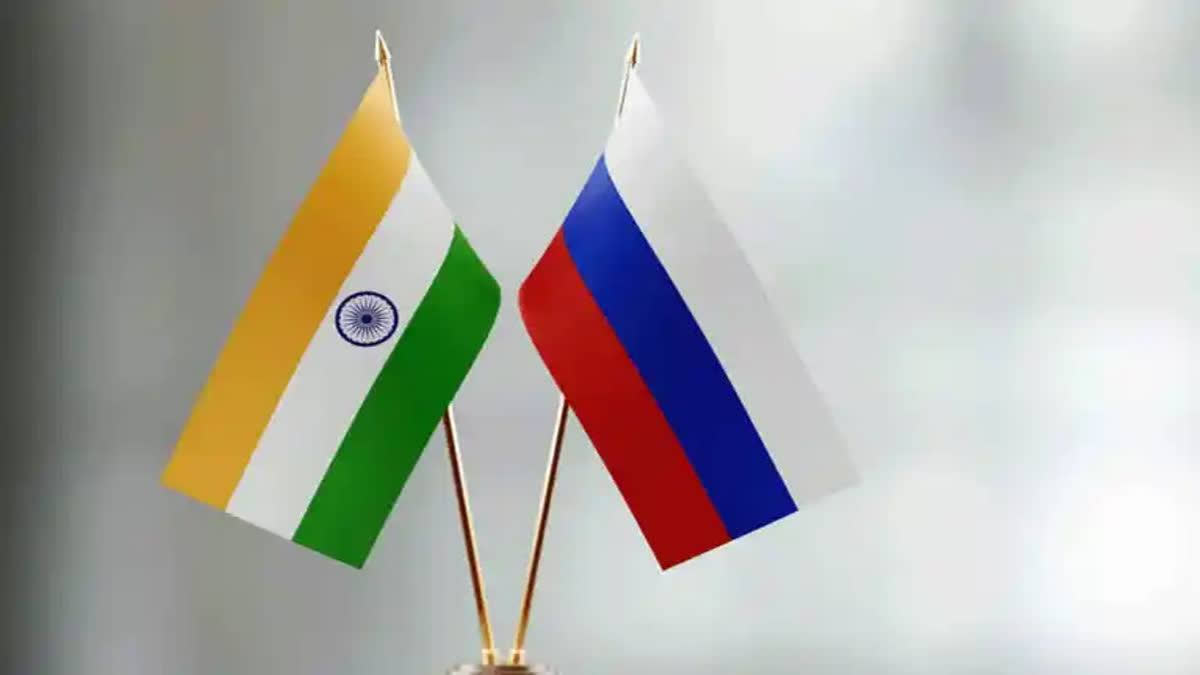New Delhi: Among the plethora of issues that will come up for discussion during the 22nd India-Russia Annual Bilateral Summit during Prime Minister Narendra Modi’s visit to Moscow next week will be bilateral trade. Though bilateral trade between India and Russia has increased over the years, it has largely remained imbalanced and is tilted heavily in favour of Russia.
Addressing a pre-departure media briefing here on Friday, Foreign Secretary Vinay Kwatra said that India-Russia bilateral trade has seen a sharp increase in 2023-24 and has since touched close to $65 billion primarily due to strong energy cooperation between the two countries.
“We have Indian exports of $4 billion and Indian imports close to $60 billion,” Kwatra said. “Trade remains imbalanced which is a matter of priority in our discussions. We have growing investment ties between the two countries, including in the fields of energy, banking, railways and steel. These are growing areas of our investment partnership.”
According to the Indian Embassy in Moscow, intensifying trade and economic relations has been identified as a priority area by both Modi and Russian President Vladimir Putin. The two leaders had earlier set the targets of increasing bilateral investment to $50 billion and bilateral trade to $30 billion by 2025.
“As per figures of the Department of Commerce, in FY 2023-24, bilateral trade has reached an all-time high of $ 65.70 billion (total bilateral merchandise trade for FY 2023-24: $65.70 billion; India’s exports: $4.26 billion; and India’s imports: $61.44 billion),” a statement issued by the Embassy reads. “Major items of export from India include pharmaceuticals, organic chemicals, electrical machinery and mechanical appliances, iron and steel, while major items of import from Russia include oil and petroleum products, fertilisers, mineral resources, precious stones and metals, vegetable oils, etc.”
According to the statement, bilateral trade in services has remained stable during the last five years with trade balance in Russia’s favour. It amounted to $1.021 billion for the year 2021. “Bilateral investments between the two countries remain strong and surpassed the previous target of $30 billion in 2018, leading to a revised target of $50 billion by 2025,” the statement further reads. “The major bilateral investments by Russia in India are in the oil and gas, petrochemicals, banking, railways and steel sectors, while Indian investments in Russia are mainly in oil and gas and pharmaceuticals sectors.”
What are the reasons behind this trade imbalance between the two countries?
The trade imbalance between India and Russia can be attributed to a variety of factors encompassing economic, geopolitical, structural, and market-specific elements.
India imports a significant amount of crude oil, petroleum products, and coal from Russia. Energy imports form a substantial portion of India’s overall imports from Russia, heavily tilting the trade balance. Given India’s energy needs and Russia’s role as a major energy supplier, this aspect is a crucial driver of the trade imbalance. There was a sudden jump in imports from Russia, mainly oil and fertilisers, which began to surge earlier in 2022. This was the main reason behind this increase in bilateral trade. Petroleum oil and other fuel items accounted for 84 per cent of India’s total imports from Russia, while fertilisers were second.
Indian exports to Russia are relatively diversified but include pharmaceuticals, agricultural products, machinery, and textiles. However, the volume and value of these exports are not enough to offset the substantial imports of energy products from Russia.
Western sanctions on Russia have altered trade patterns, pushing Russia to seek alternative markets for its exports, including India. These sanctions have also limited Russia’s ability to export certain high-value goods, thereby impacting the balance.
India and Russia share a Special and Privileged Strategic Partnership and defence-related trade comes under this. However, defence-related trade is often not reflected in the regular trade statistics as it is typically covered under government-to-government agreements and financing arrangements.
There are logistical challenges too. Geographical distance and the associated logistical challenges can increase the cost of trade between India and Russia. Poor transport infrastructure, long transit times, and higher transportation costs can hinder the competitiveness of Indian goods in the Russian market.
There are limited direct shipping routes and air links between India and Russia, which can further complicate and add to the cost of trade.
So, how can this trade imbalance be rectified?
“As far as the question of correcting the trade imbalance is concerned, India is trying to increase exports in all areas, be it agriculture, technology, pharmaceuticals or services,” Foreign Secretary Kwatra said during Thursday’s briefing. “We will make all efforts to ensure that exports from India to Russia increase in all these areas. The faster this happens, the sooner the trade imbalance can be rectified.”
He further said that the issue of trade imbalance has always been an important issue during discussions between the two countries. “It also should be noted that the target set by the two countries by 2025 has also been surpassed,” Kwatra said. “We will set a higher target in the coming years.”
Apart from agriculture, technology, pharmaceuticals and services as mentioned by Kwatra, observers believe that India also needs to promote its textiles, gems, and jewellery in the Russian market. Expanding cooperation in IT and software services and increasing tourism between the two countries through targeted marketing and easier visa processes can boost services trade.
India and Russia have also entered advanced negotiations over a free trade agreement (FTA) that aims to build closer economic ties as most Western governments push to isolate Moscow over the war in Ukraine. The absence of an FTA between India and Russia limits the potential for a balanced trade relationship. An FTA could facilitate greater market access and reduce trade barriers.
A bright side in rectifying the trade imbalance has been the rise in the use of local currencies for trade, thereby reducing dependence on the US dollar and lowering transaction costs. In April this year, almost two years after the Reserve Bank of India announced new steps for rupee-settled global trade, Russian banking major Sberbank said it has seen a steady increase in volumes for rupee-rouble payments for Russia’s imports from India.
But above all, it is improving the transport infrastructure that is most important for rectifying the trade imbalance between the two countries. Here, the International North-South Transport Corridor (INSTC), the Chabahar Port in Iran that India is investing in and the Eastern Maritime Corridor linking Chennai and Vladivostok in Russia's Far East that is being explored come into play. During his briefing, Kwatra stressed the importance of these transport routes.
The INSTC is a 7,200-km-long multi-mode network of ship, rail, and road routes for moving freight. India, Iran, and Russia had in September 2000 signed the INSTC agreement to build a corridor to provide the shortest multi-model transportation route linking the Indian Ocean and the Persian Gulf to the Caspian Sea via Iran and St Petersburg. From St Petersburg, North Europe is within easy reach via Russia.
The estimated capacity of the corridor is 20-30 million tonnes of goods per year. The route primarily involves moving freight from India, Iran, Azerbaijan, and Russia via ship, rail, and road. The objective of the corridor is to increase trade connectivity between major cities such as Mumbai, Moscow, Tehran, Baku, Bandar Abbas, Astrakhan and Bandar Anzali.
Recently, Russia has sent two trains carrying coal to India through the INSTC for the first time. The consignment would be covering over 7,200km from St Petersburg to Mumbai port via Bandar Abbas port of Iran.
The Chabahar port in Iran will help India benefit from Iran’s unique geographical position to access markets in Central Asia, Afghanistan and Eurasia. It provides India with a strategic foothold in the region, offering access to Afghanistan and Central Asia while bypassing Pakistan.
The port provides an alternative route for Indian goods to reach Afghanistan and Central Asia, reducing dependency on the more costly and politically sensitive route through Pakistan. Additionally, Chabahar facilitates access to Iran’s vast market and serves as a gateway for Indian businesses to expand their presence in the region.
The Eastern Maritime Corridor is a new route that is being explored. Addressing a conference in Chennai in January this year, Union Minister for Ports, Shipping and Waterways Sarbananda Sonowal elaborated on how this route will significantly reduce time and distance in the transport of cargo between India and Far East Russia.
"Presently, the distance between Mumbai Port and the Port of St Petersburg, Russia, by the Western Sea Route via the Suez Canal is 8,675 nautical miles or 16,066 km whereas the distance between Chennai Port and Vladivostok Port via the Eastern Maritime Corridor is only 5,647 nautical miles or 10,458 km,” Sonowal said. "There is a clear cut savings of 5,608 km that would immensely reduce logistics cost, apart from boosting efficiency in transportation of cargo between the two nations."
It is in light of all these that bilateral trade between India and Russia is an important issue during discussions between the two sides and so it will be in the Annual Bilateral Summit in Moscow next week.
Read more: Significance Of PM Modi's Visit To Moscow: The First Since The Ukraine War



